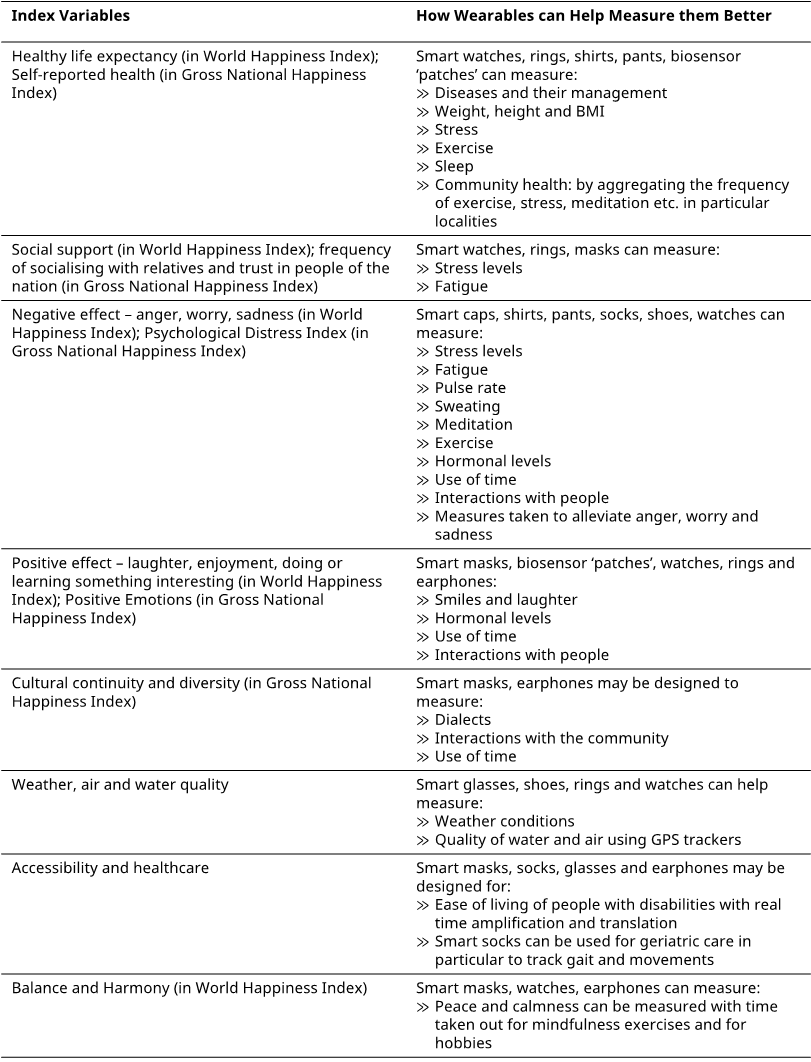In the last couple of decades, the way we understand development in the modern world has become more abstract. Attempts have been made to capture facets of ‘happiness’: Joy, satisfaction, community interactions, and relationships with economic growth, education, and health to paint the picture of well-being. We now understand that well-being is holistically derived from physical and mental health, social life, work, productivity, and social environment. Some of the indices that measure this are Human Development Index, Gross National Happiness Index, and World Happiness Index. Most of these depend on data from censuses, GDP estimates, economic and social surveys, etc. Some, such as the World Happiness Index, administer their own questionnaire to a sample representative population in each country. However, they still face constraints of limited sample size and different contextual understandings of abstract concepts such as ‘peace’ and ‘balance’. Some are assumed to rely too much on the short-term memory of individuals, with questions such as, “Did you experience the following feelings a lot of the day yesterday? How about happiness? How about sadness?” (as seen in the World Happiness Index).
To analyse the abstraction of well-being, it is important that we make use of as much reliable, dynamic, and real-time data as possible. For instance, one way to quantify worry is by asking, “Did you experience the following feelings during a lot of the day yesterday? How about worry?”, as done in the Gallup World Poll. This question relies too much on the individual’s memory and does not capture the nuance of ‘being worried’. A more objective way would be to complement this with data on the individual’s physiological processes and social interactions: The amount of stress they were in, how they spent their day, whom they interacted with and how much, and what they did to alleviate their worry. To capture this, we need to expand the ways in which we collect data beyond telephonic and face-to-face interviews.
For the past couple of decades, the scope of Artificial Intelligence (AI) has increased multi-fold. AI is used to create autonomous systems that can learn and act based on data collection, recording, and studying previous observations. Using AI and Internet of Things (IoT)— particularly wearables—to measure, record, and learn from behaviour patterns and lifestyle can be a giant leap towards understanding the dynamics of well-being.
Table 1: A snapshot of data various wearables capture and the technologies they use
| Wearable | What it can do |
 |
Hexoskins and smart shirts use actigraphy and photoplethysmography, among other technologies, to measure breathing, heart rate, movement, cadence, sleep, posture and abdominal changes post meals. |
 |
Smart belts use a gyroscope to measure abdominal changes post meals, steps taken, sitting and standing time. It also encourages movement. |
 |
Smart pants can measure movement and some changes in the body post meals and workouts. |
 |
Smart socks were designed for geriatric and patient care and can measure motion, gait, and alert caregivers using triboelectric pressure sensors. |
 |
Smart shoes use accelerometers, pressure sensors, inertial magnetic management units, atmospheric pressure sensors, light and sound sensors, pedometers. They can measure movement, gait, and posture. They are also being equipped with GPS sensors and light. Technology such as obstruction sensors which might be useful for people with visual impairments is being embedded in them. They can also monitor weather. |
 |
Smart rings can measure pulse, oxygen, and stress levels, temperature, sleep, and workout. They use actigraphy to measure movement during sleep. While this is not the most accurate way to measure sleeping rhythms, it is commonly used and can be adopted for preliminary analyses. Watches can also be used for payments and emergency calls. |
 |
Smartwatches can be used for calls, messaging, and photography. They are also used to measure workout, sleep, pulse, oxygen, and stress levels. |
 |
Smart glasses use display sensors and augmented reality. They can be used for calls, photography, and navigation. They are also being developed to help people with visual impairments. |
 |
Smart masks not only self-clean but can also predict fatigue and emotional states. They can be leveraged to measure the frequency and type of social interactions. |
 |
Smart earphones and headphones are being developed to translate real-time interactions. Smart hearing aids help enhance people with auditory disabilities. They can be leveraged to measure the frequency and type of social interactions. |
 |
Smart caps can monitor fatigue and help people with visual impairments. Smart helmets in the headwear segment are useful for road emergencies and navigation. |
 |
Development of insertable technology such as ‘ultra-human’ patches is picking up pace. These patches monitor real-time changes in glucose and activity levels by using continuous blood glucose monitoring sensors and also advise changes in routine. |
Using Data from Wearables for Measuring Well-being
The table below posits the indicators that indices are trying to measure and how wearables can provide a more nuanced understanding:
Table 2: How Wearables can Help Measure Well-being Index Variables Better

Wearables are unique because they can capture precise and real-time data of aspects which earlier required significant funds and research capacities. For instance, wearables can capture the intensity of exercise, quality of sleep, blood sugar monitoring, emotional states, and frequency of social interactions. Therefore, they can make meaningful contributions to understanding psychological well-being; health (not just an individual but community health, fitness, common diseases, and habits); how people are using their time; the kind of ecological conditions that people are experiencing; and eventually who people are interacting with and across what breadth of topics.
Operationalising: How to Use this Data
Currently held by companies who design and make wearables, data gathered may be sold to third parties. Given the breadth of data captured, the State or international organisations such as the United Nations (UN) can leverage it towards a larger societal-wellbeing analysis. Companies can be asked to make fitness and health profiles of the various data points they collect and share these profiles with the State. Since companies may incur a commercial loss from this, the State can compensate for it. Another way to leverage this data for well-being analysis is by bringing in an independent consultant organisation which can conduct an analysis of the data shared.
In the context of handling data, particularly sensitive health data, India Stack comes to mind. India Stack was conceptualised with the foundation of Aadhaar, which brought Indian citizens into the fold of the formal economy. Then, Unified Payments Interface (UPI) was introduced to formalise transactions in inexpensive ways. Eventually, with a drastic increase in digital transactions, we are now sitting with massive data of our digital economic interactions. In light of our privacy and right to data, the Personal Data Protection Bill prescribed the creation of a financial intermediary called Account Aggregators (AAs). These AAs are consent managers, empowering people to know and choose the data they wish to share. Third parties, which wish to access the financial data of individuals, are envisioned to send consent requests to users explicitly stating the purpose and the duration of access to data, which they can disapprove. A similar tech stack for wearables data can be built. All the data from wearables can be standardised and consent managers can empower people to share the kind of data they want, and with whom. This will arguably foster more power with individuals regarding the use of their data. While ensuring the anonymity of the individual sharing the data, the State or international organisations will also be able to access the health and well-being profiles of communities.
G20 and Wearables
Given their current relatively expensive range, wearables are bought by only a small proportion of the population. Thus, data collected from them may not be representative. This should not stop nation-states from leveraging such meticulous data to understand the well-being needs of their citizens. Moreover, with heavy discounts on the prices of wearables, the public’s appetite, particularly for smartwatches, is increasing. According to the International Data Corporation’s quarterly tracker, India shipped a record total of 75 million wearables in the first three quarters of 2022. The global wearable technology market is US $116.2 billion, most of which is growing in most G20 member countries. The G20 platform, which aims to strengthen global governance and architecture on major economic issues, represents around 85 percent of the global GDP and about two-thirds of the world population. In this context, G20 countries can be pioneers in redefining and nuancing well-being. The countries can also collaborate towards formulating policies that can pave way for the effective growth of wearable technology. Italy used the G20 Summit in 2021 to launch the Innovation League, which discussed how IoT and wearable technology can complement human well-being and lifestyle. Task Force 3 of the Think20 India, which discusses LiFE, Resilience and Values for Wellbeing, can develop a framework for regulating the use of wearables for data collection. The G20 countries can introduce an all-encompassing committee that can deliberate on IoT and wearables in well-being.
In conclusion
Indices are adopting newer ways to decode well-being. A recent attempt used social media text analysis to measure people’s emotional experiences in the World Happiness Index. Wearables are a giant progressive step on this path. As the infrastructure to manage and analyse this data emerges, it could show us a way to integrate newer ways of real-time data collection for well-being. This will make us less dependent on yearly surveys and help G20 countries design more evidence-based interventions. It will also pave the way for more contextual research in domains of well-being. Wearables capture the pulse of how an individual leads their life every day and will paint a sophisticated contextual understanding of well-being on metrics which can be applicable to all people.
(This essay is a part of the commentary series on G20-Think20 Task Force 3: LiFE, Resilience, and Values for Wellbeing)




